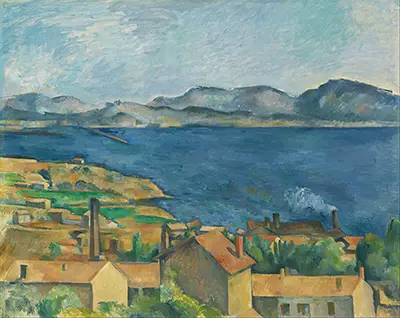The French artist Paul Cézanne started to paint in his home town of Aix-en-Provence in 1860, before later moving to Paris.
Subjects and themes for his early work were classical, dark colours being laid on with expressive brushwork in the style of Delacroix, and applying dramatic tones and thick pigment layers. The Sea at L'Estaque, however, is a masterpiece from the artist's mature period, when evenly-applied brush strokes imbued landscapes with a calming effect.
Cézanne had been working in Northern France with the Impressionist Camille Pisarro, who persuaded him to move away from his dark-coloured schemes. Although influenced by his friend, Cézanne himself was not part of this movement, being unconvinced by the theory that painting is merely a reflection of the visual. His individualism was closer to being a forerunner of Fauvism and Cubism, as this painting confirms. However, he was influenced by the en-plein-air style of the Impressionists, which he has employed here, and in fact, he provided a link between their ideas and later movements.
In the spring of 1876, he decided to return to southern France, staying in a fishing village near Marseilles, which went by the name of L'Estaque. Working outdoors, he was mesmerised by the dazzling but merciless Mediterranean light which picked out every shade, but also had a tendency to flatten images. In a letter to Pisarro, he likened the vistas he saw to a playing card, with red roofs against blue sea.
Paul Cézanne painted many pictures from the viewpoint of L'Estaque, where he loved to stay. The Bay of Marseilles filled countless canvases, and provided the artist with endless opportunities to develop his later style. The Sea At L'Estaque was completed at a time when the artist was confident in his vision. The vibrant colours are evident both in the solid houses of the foreground, and in the expanse of sea and sky beyond, conveying a realistic impression of space.
As with his other mature landscapes, by now Cézanne had developed the ability to show solidity and depth, portraying both flatness and space, and maintaining that he wanted to "show perspective only through colour". He was fascinated by the harmony and colour that he found in the landscapes and seascapes of the south of France, and applied strokes of his brush in a methodical way that made every inch count. His analytical approach was greatly admired by future movements such as Cubism, so that his influence has continued to feed into trends in art today. Fittingly, one version of The Sea At L'Estaque now belongs to the Musée Picasso in Paris, having been acquired by Pablo Picasso himself.




